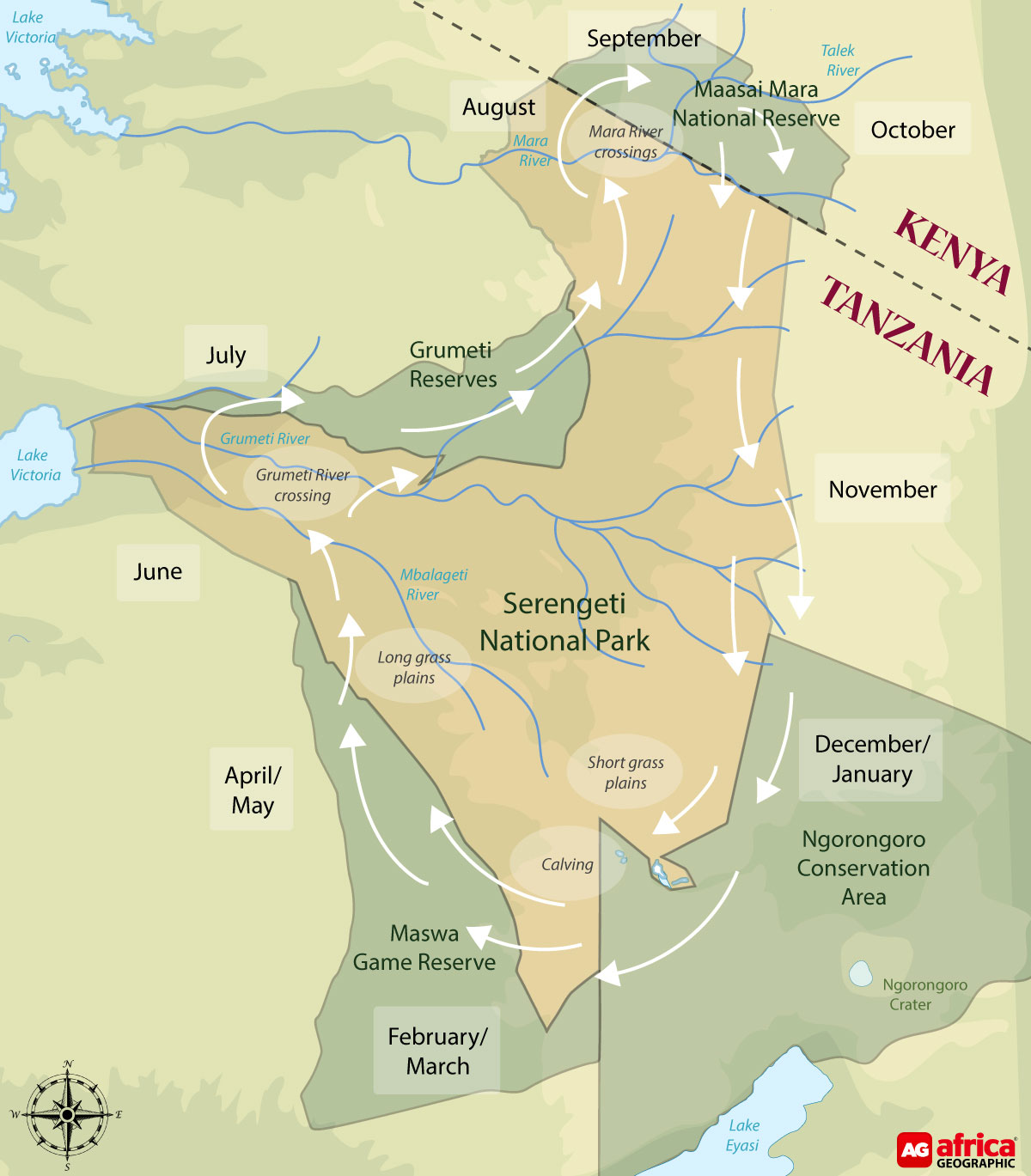An Unrivalled Wildlife Spectacle
THE GREAT WILDEBEEST MIGRATION
The great wildebeest migration is one of the world’s most spectacular natural phenomena. Every year millions of wildebeest and zebra migrate in a continuous circle through Tanzania’s Serengeti National Park and Kenya’s Masai Mara. The journey follows a similar pattern year on year as the vast herds follow the rain.
A wildebeest migration safari is a sought-after experience that wildlife enthusiasts flock to. It is at the top of the bucket lists around the world and for good reason. The ever-moving circular migration gives you ample opportunity to see the herds throughout the year. The wildebeest migration moves in a clockwise direction from the southern Serengeti in February, through the Central and Western Serengeti, with the Grumeti River crossing in May, across the treacherous Mara River in July and August and back again, along the Eastern Serengeti, from October.
The animals move in a broadly predictable pattern, with the exact timing of the migration depends entirely on the rainfall pattern of each year. Our guide is the general cycle the animals take each year, which does help you plan a wildebeest migration safari.
What is the Great Wildebeest Migration?
The great migration is made up of over 1.5 million wildebeest, 350,000 Thomson’s gazelle and about 200, 000 zebra along with thousands of the large eland and other hoofed animals. These three main groups of animals all eat different parts of the grasses which means that they do not compete for food and make perfect grazing partners. While predators do not necessarily migrate, the vast herds support very healthy lion, cheetah, leopard and hyena populations across the Serengeti-Mara ecosystem. Not to mention the crocodiles who lie in wait in rivers like the Grumeti River and Mara River for their yearly binge meal.
There is high drama throughout the year as safari-goers watch babies being born and the stragglers becoming a predator’s next meal, all in an ever-changing and beautiful landscape.
What time of year is the Wildebeest Migration?
The great migration follows a loosely clockwise circular route through the Serengeti-Mara ecosystem. The herds swell with new life in January however by the time they return south at the end of November their numbers have been substantially reduced by predators like lion, leopard, cheetah and hyena, by the raging waters of the Mara River and the massive crocodiles that lie in wait.
The herds in January, February and March
By January of every year, the wildebeest have finished the migration south from the Masai Mara, along the eastern edge of the Serengeti and into the southern plains of the Serengeti and the Ngorongoro conservation area ( Not the Ngorongoro Crater).
Many of the females are heavily pregnant by the end of January. The vast plains of the Ndutu area have been revitalised from the rain and are providing nutritious food for the herds to raise their newborn calves. Over 400,000 calves are born within a period of two to three weeks during late January and February. The herds spread through the lower Serengeti, Ndutu area and the Ngorongoro Conservation area, as well as around Lake Masek and Lake Ndutu. There is enough food for the animals to remain in this area for a while.
The very healthy lion populations and other predators like Cheetah are out in full force during these months. The Serengeti boasts a staggering 3000 lions, which makes the whole park an important conservation area for the lions.
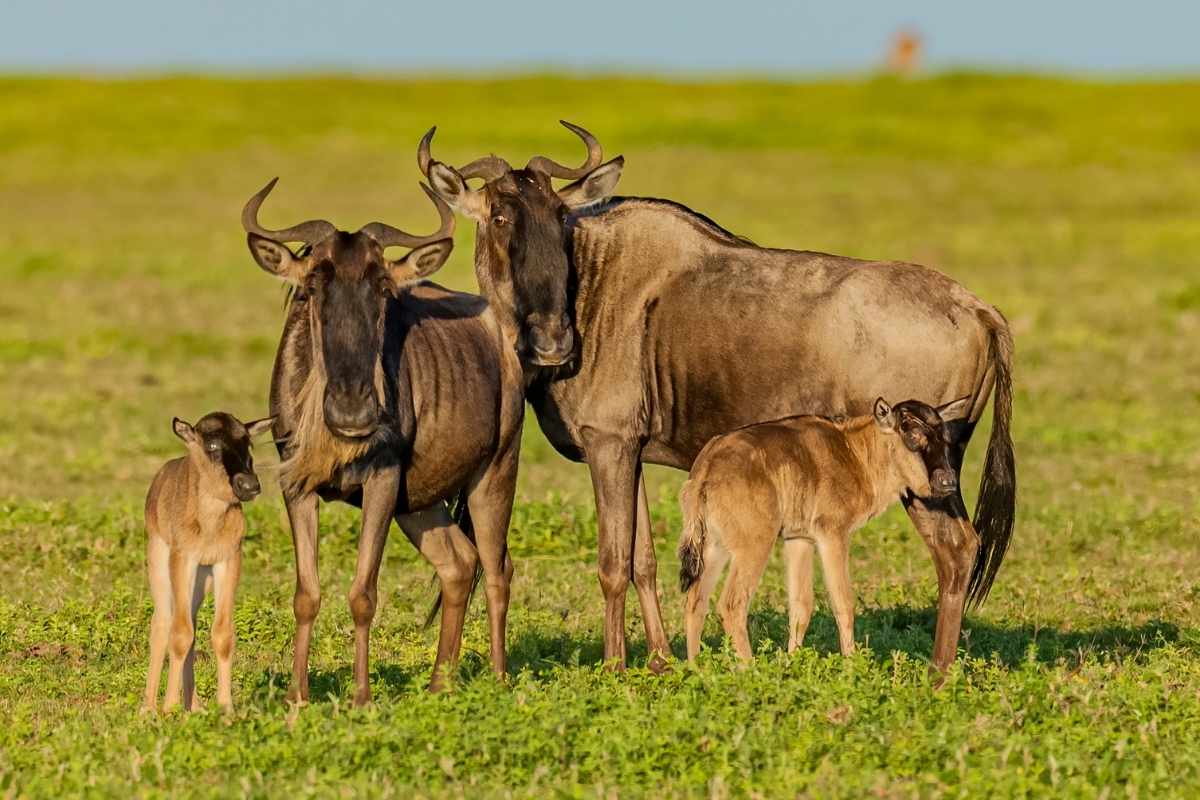
The herds in April and May
From April and May, the calves are strong enough to start moving North. The wildebeest drift north into the central Serengeti and fresh grass. This time of year does coincide with the long rains and you should be prepared for daily rain. The wildebeest migration stretch for several kilometres wide as the animals spread out over the central Serengeti. If you can brave the rain and the muddy tracks, this time of year is incredible for lion and other predator sightings. The journey the wildebeest take continues at leisure through the Central Serengeti.
The herds in June and July
The dry season starts in June with the wildebeest, zebra and Gazelle congregating in the Western Serengeti and the banks of the Grumeti River. The wildebeest migration herds need to cross over the Grumeti River to continue onto the Masai Mara. This is the first of the river crossings on the annual trek, but not as dramatic as the Mara River crossing. This is also the time that the animals start mating.
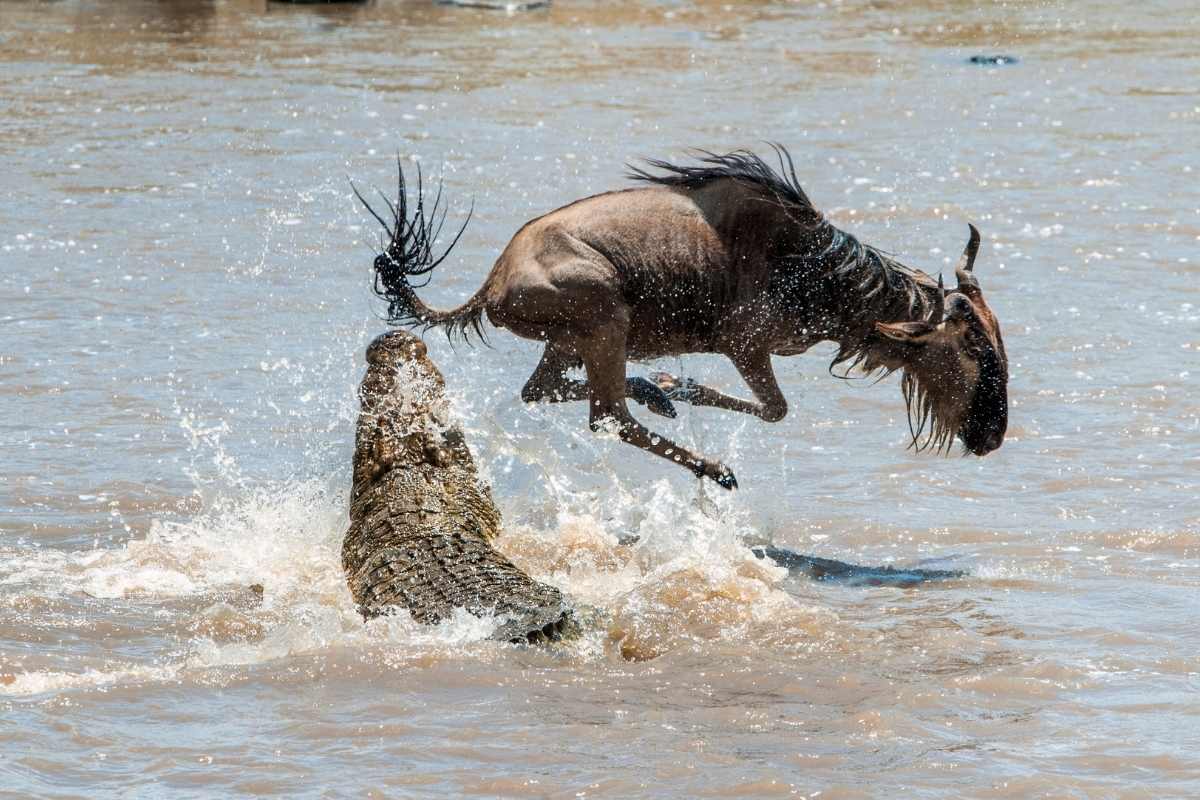
The herds in August, September and October
By late July and August, the majority of the herbs have headed to the northern Serengeti plains and the forward groups can be found in the Masai Mara. The biggest obstacle on the migration route to be faced is the Mara River and this is the highly sort after dramatic event visitors want to see. Most of the Mara River is in the public national parks, so there will be some jostling of space to get a good view.
Small groups or hundreds of animals at a time cross crocodile-infested waters of the rapidly flowing Mara River. Nature is at its most raw during the river crossings, with crocodiles snapping numerous meals in a day, hyenas and lions prowling the banks looking for an easy dinner and sadly the river itself claims victims which in turn feed the fish and birds.
In September and October majority of the herd have crossed into the vast open plains of the Masai Mara although some remain on the northern plains of the Serengeti. Casual grazing in the Masai Mara continues through October until the short rains of November trigger the internal clock of the wildebeest to start moving south.
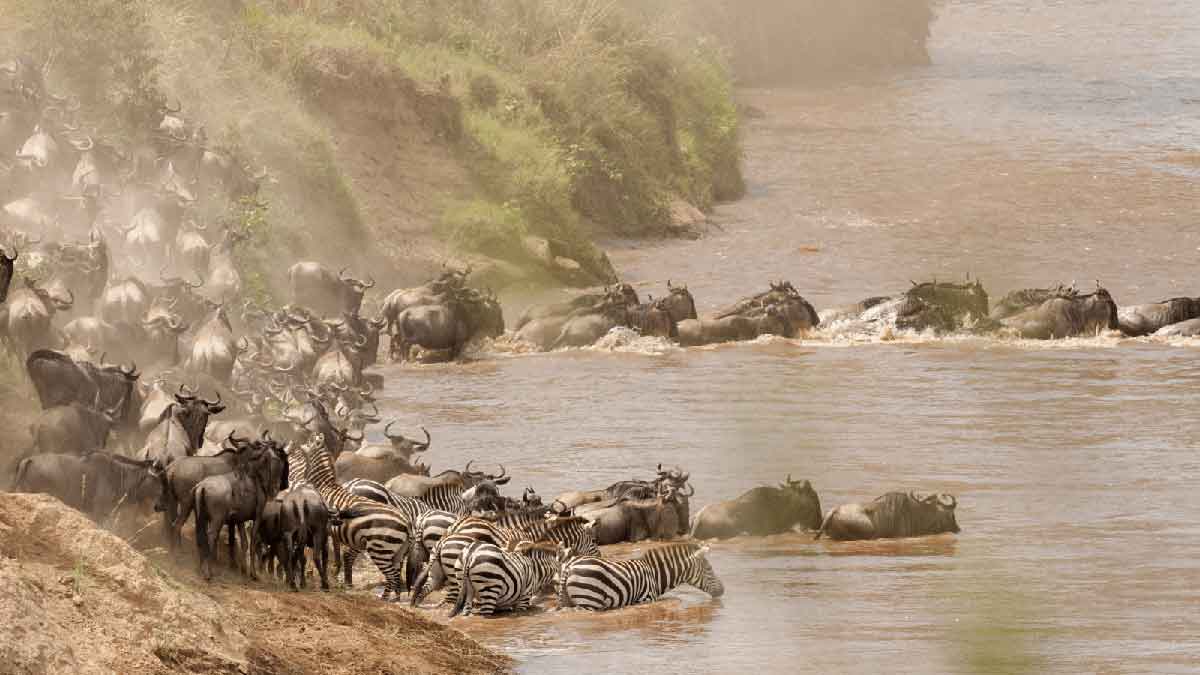
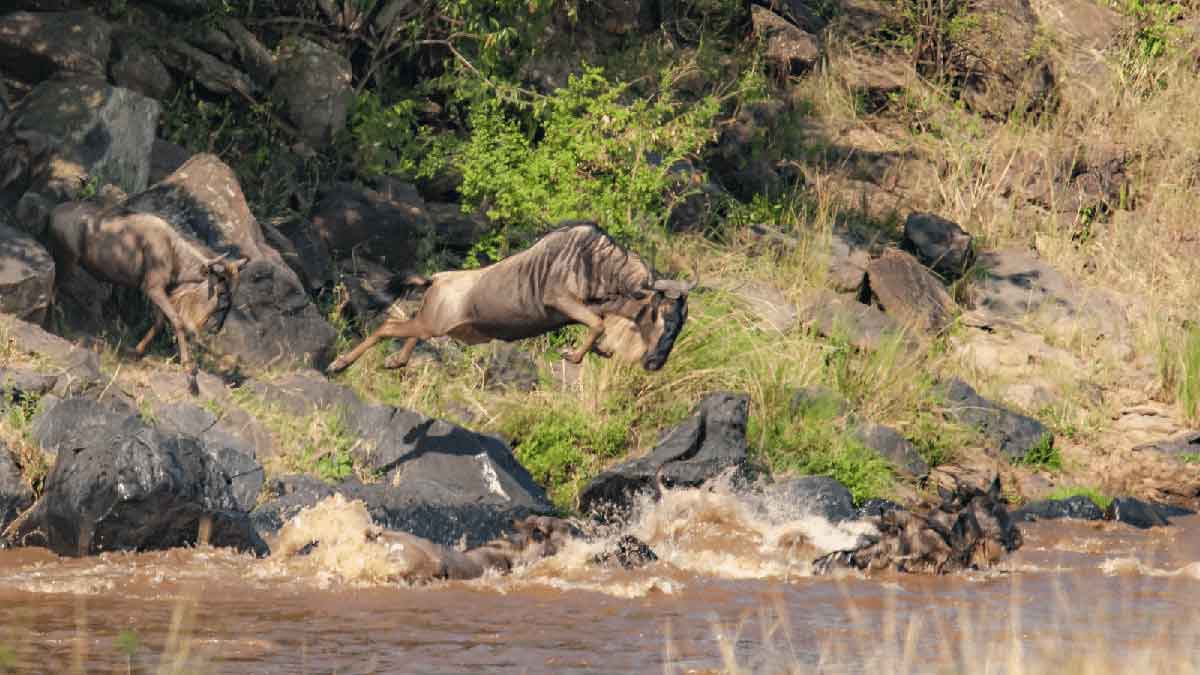
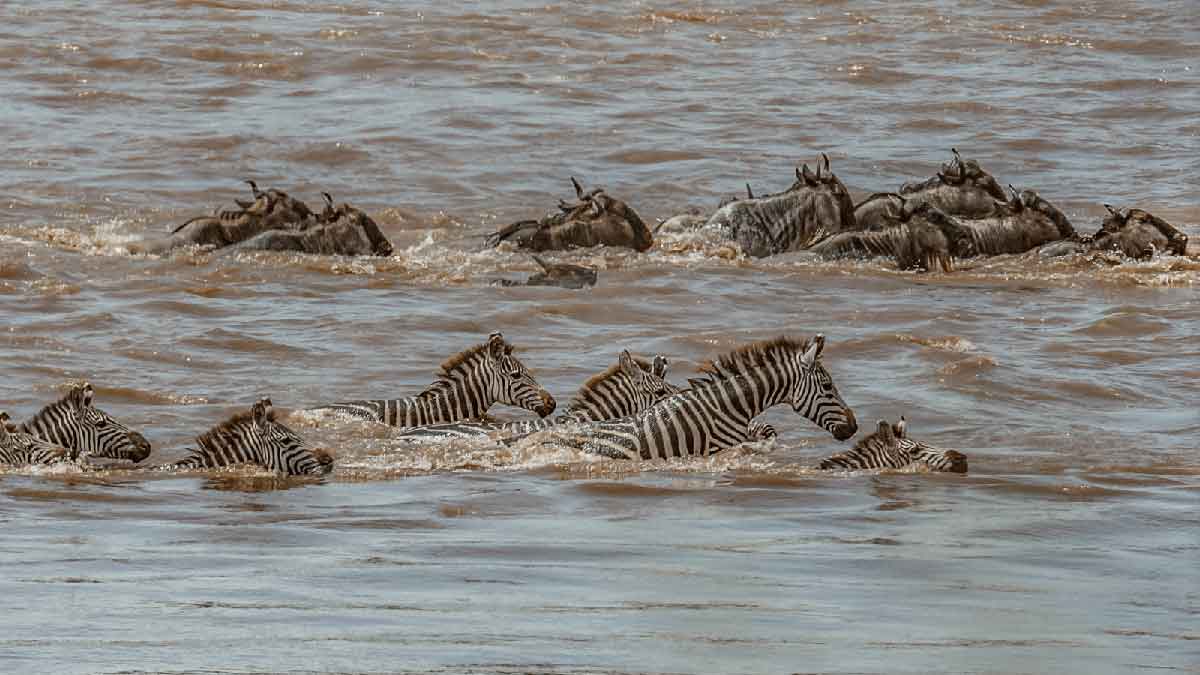
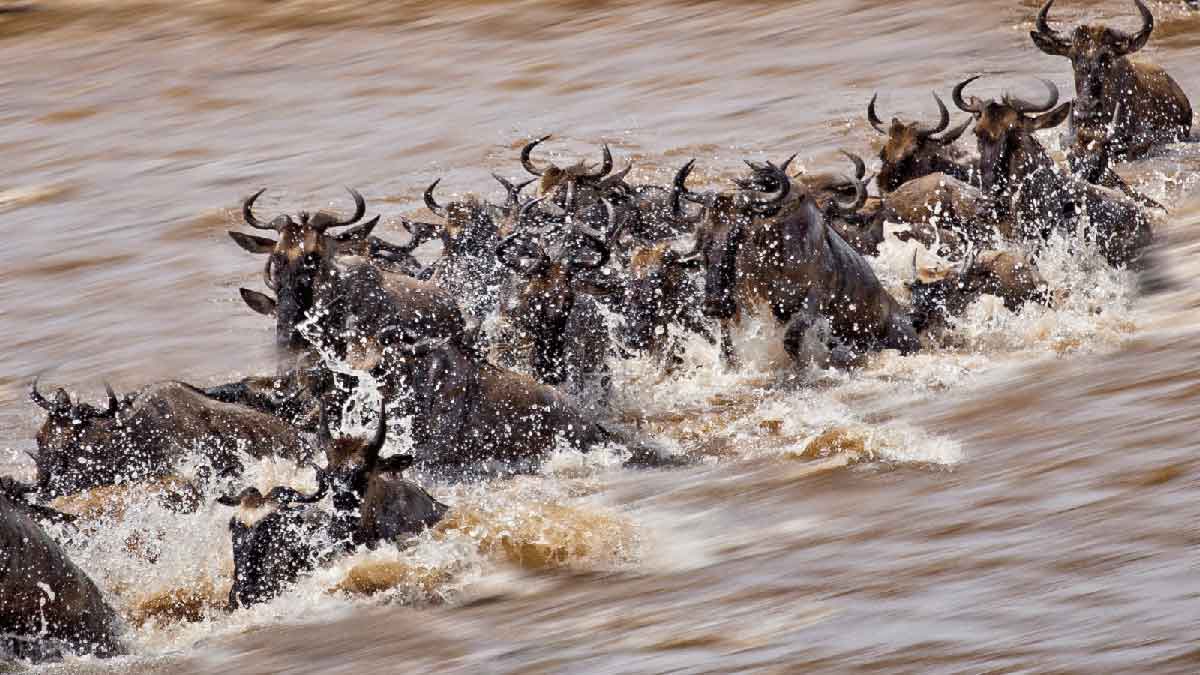
The herds in November and December
Coinciding with the short rains of November, the majority of the wildebeest migration turns back towards Tanzania and into the Serengeti. The herds have spread out on the southward trek, continuing the annual cycle south along the Eastern edge of the Serengeti and down to the plains, crossing over fertile lands of the Eastern and Central Serengeti. The cycle continues as the herds reach the southern Serengeti plains in January, have their babies and start their annual migration again.
Where is the Wildebeest Migration?
The East African countries of Tanzania and Kenya are where you will find the great wildebeest migration. The herds migrate between Tanzania’s Serengeti National Park and surrounding reserves and Kenya’s Masai Mara National Reserve and private conservancies. There are no barriers to movement over this vast Serengeti-Mara ecosystem, allowing the herds to move easily.
River Crossings
When people think of the wildebeest migration they think of the action-packed river crossings we have watched in documentaries for years. River crossings can never be predicted, not even the herds know when or where they cross. With numerous false starts, herds looking but not jumping, or walking along a high cliff and startled by a lion, you just never know when they will cross, or how many will cross at a time. This is why we do suggest at least 3-4 nights in a safari lodge that can easily access various points on the river, even visiting 2 different lodges to maximise your chances. It is important to note that the rivers are on public land, so you will be jostling for a spot to watch.
Where to stay
In the Serengeti there are permanent camps and mobile camps that track the migration, moving between 2 and 5 times a year. These are authentic but luxurious camps. The permanent camps range from comfortable rustic to some of the very best safari lodges in Africa. The camps in the Masai Mara tend to be permanent, and most are also under canvas.
All year round Central Serengeti
There is no camp that can view the migration for the whole year, however staying in the Central Serengeti and Seronera River Valley you are able to see most of it! Full-day trips complete with picnic lunch and lots of snacks will take you south, north, east and west in search of the migration. Remember it is the long rains in Tanzania during April and May, only drying out by the end of May into June. The short rains happen in November and December, but most camps remain open.
We love Lemala Ewanjan Tented Camp, the all-female team at Dunia Camp, Elewana Serengeti Pioneer Camp, Mbali Mbali Soroi Serengeti, One Nature Nyaruswiga Serengeti, and Kubu Kubu Tented Lodge. Namiri Plains and Lemala Nanyuki are in the Eastern Serengeti which is also great game viewing.
Calving Season – January to April
The Southern Serengeti, Ndutu area and the Ngorongoro Conservation area are home to the wildebeest herds from late January to March, early April. Many mobile camps operate here and move to the Northern Serengeti from July to October. Sanctuary Kusini and Mwiba Lodge are 2 luxurious and permanent camps. The Lemala Ndutu Camp, andBeyond Serengeti Under Canvas, Sanctuary Kichakani Serengeti Camp, Legendary Serengeti Mobile Camp, Asilia’s Olakira, Ubuntu and Kimondo Camp are all in the south at this time.
The Western Corridor – April to July
During April and May, many lodges are closed due to the heavy rains. From late May, things start to open again in the Western Corridor. The Grumeti River is a major crossing point for the Wildebeest Migration and the first of the river crossings. There are only a handful of safari lodges. andBeyond Serengeti Under Canvas and the gorgeous Singita lodges of Singita Faru Faru, Singita Sasakwa Lodge, Singita Sabora Tented Camp and Singita Serengeti House. Asilia’s Ubuntu Mobile Camp sets up in the Western Corridor until July.
River Crossings – July to October
Most of The Mara River is in Tanzania before it crosses into Kenya’s Masai Mara. So if you really want to see a river crossing, then perhaps look at some of the Northern Serengeti Camps. The Masai Mara camps do catch river crossings regularly over the Mara, Talek and Sand rivers, and the herds are sprawled over the Mara Plains in their millions which is an epic sight.
Northern Serengeti Camps: The mobile camps are all up in the North at this time – Olakira Migration Camp, Ubuntu Migration Camp, the Kati Kati camps, Lemala Mara Camp, Sanctuary Kichakani Serengeti Camp, andBeyond Serengeti Under Canvas, Roving Bushtops, Legendary Serengeti Mobile Camp and Serian Serengeti Mobile Camp.
Permanent camps in this area are andBeyond Klein’s Camp, Lemala Kuria Hills, Nomad Lamai Camp, Singita Mara River Tented Camp, Sayari Camp, Kazkaz Mara Camp, Mara Mara Tented Camp and Serengeti Bushtops Camp.
Masai Mara Camps: Cottar’s 1920, Elewana Sand River Camp, The Governors Collection and andBeyond Kichwa Tembo are top choice to maximise your chances of a river crossing scene. We love Angama Mara, andBeyond Bateleur Camp, Serian Nkorombo and Sanctuary Olonana Camp. In the private conservancies, you are away from the hustle and bustle of the Masai Mara National Reserve and can enjoy incredible game viewing. Mahali Mzuri, Mara Plains, Mara Nyika, Kicheche Mara and Kicheche Valley, Porini Lion and Porini Mara, Ngare Serian and Hemingways are great camps.
The return south – October to December
The herds are relaxed in the Masai Mara and only start their trek south when the rains start. They tend to follow the eastern boundary of the Serengeti so you can stay at any of the central lodges listed above or at one of these fine camps: Lemala Nanyuki Camp, Ehlane Plains Camp and Namiri Plains Camp are in the Eastern Serengeti and have excellent year-round game viewing.
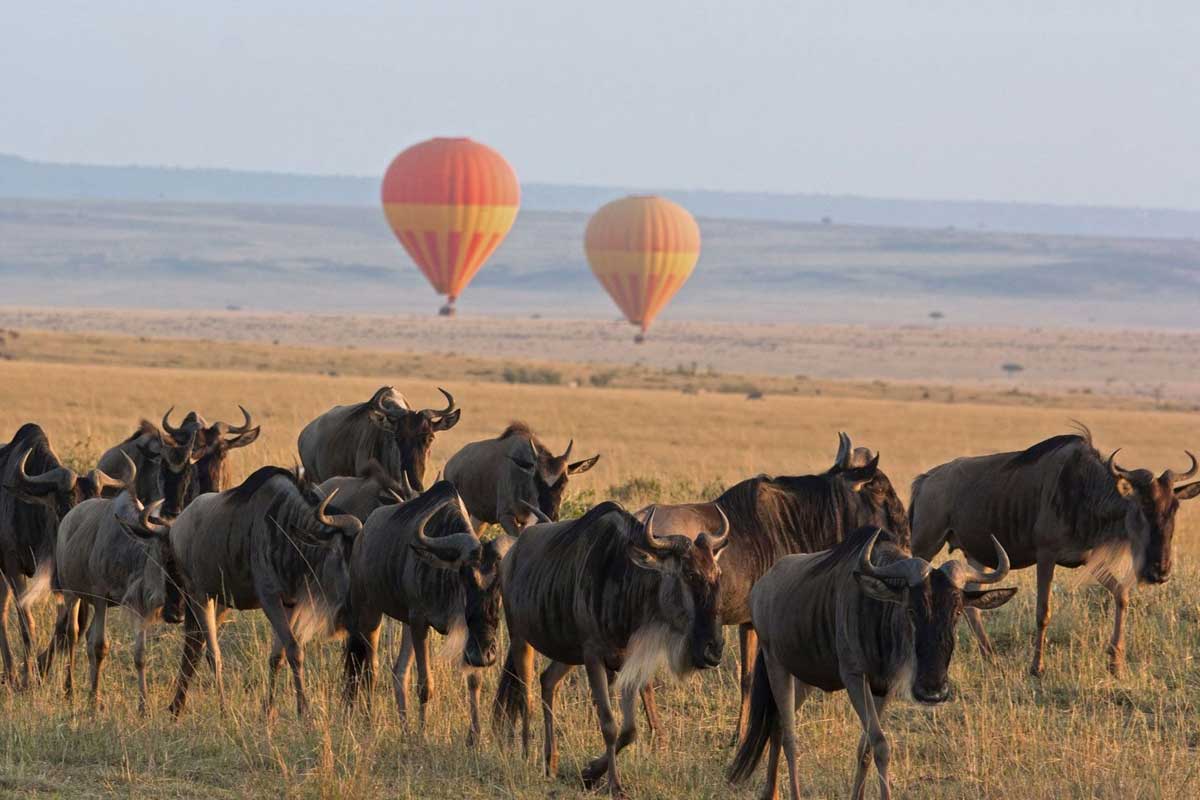
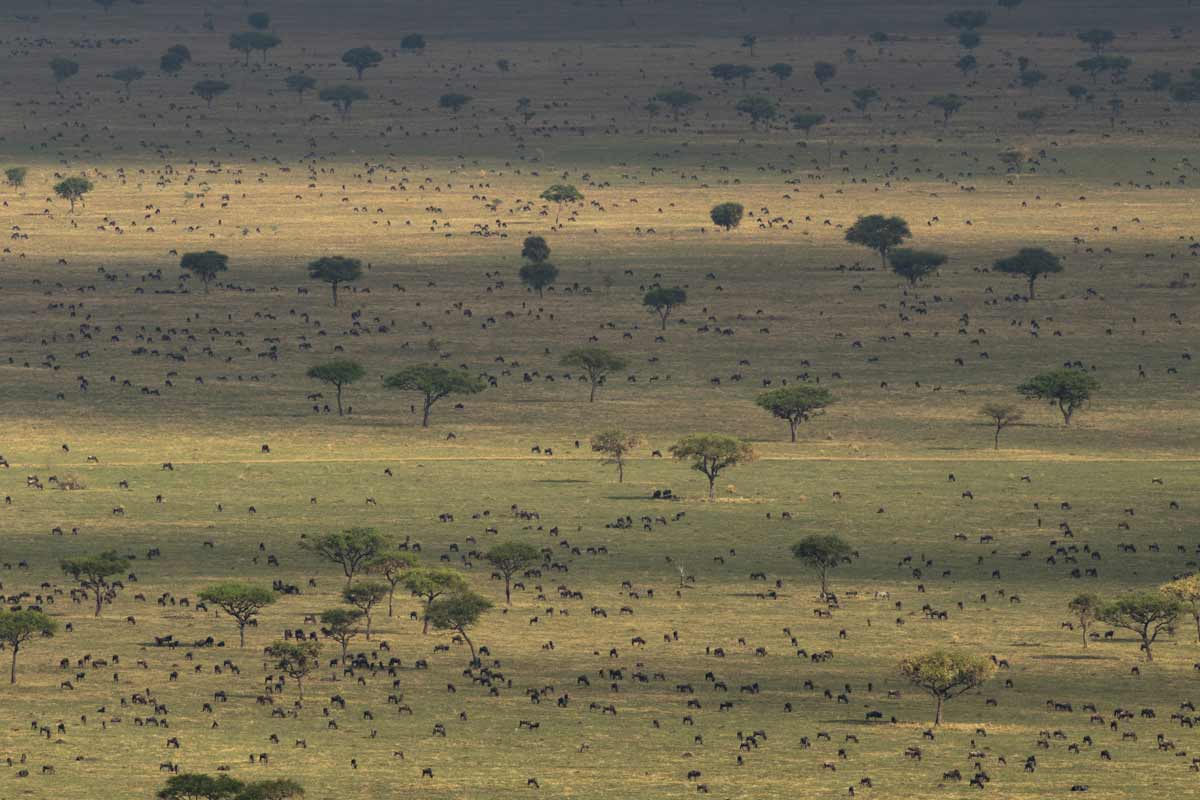
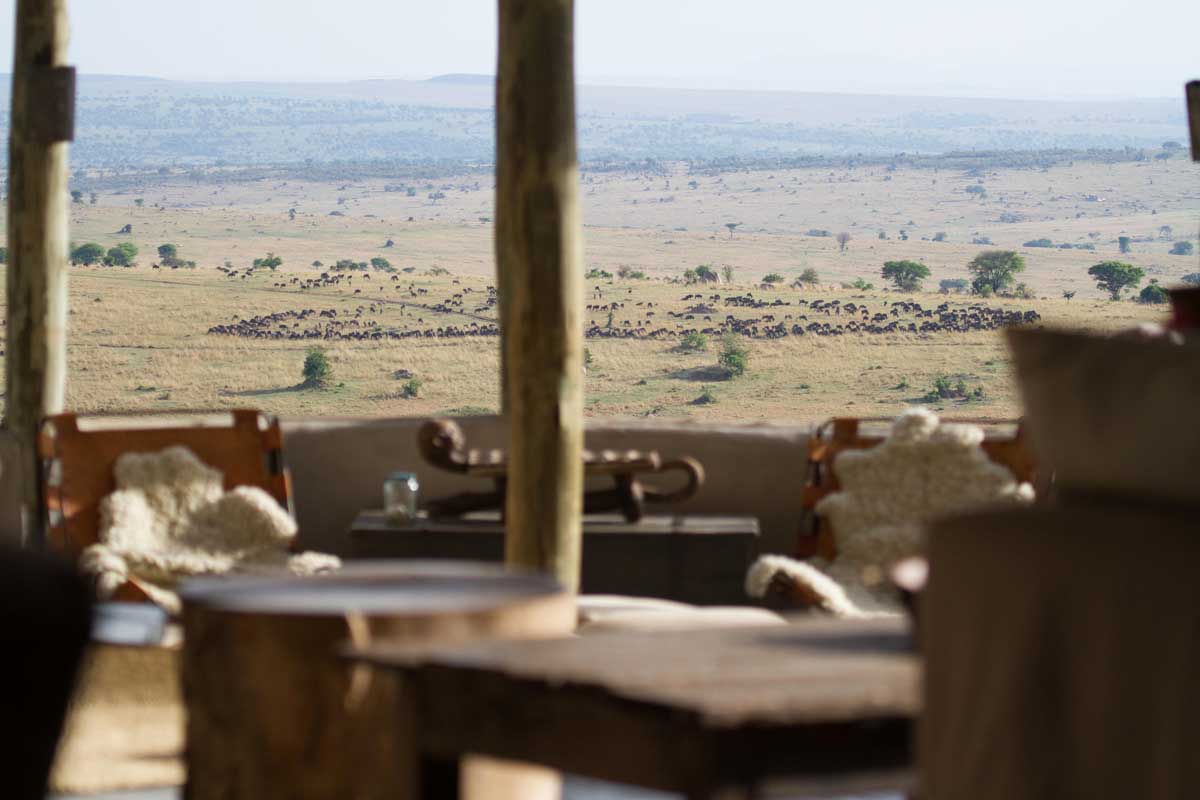
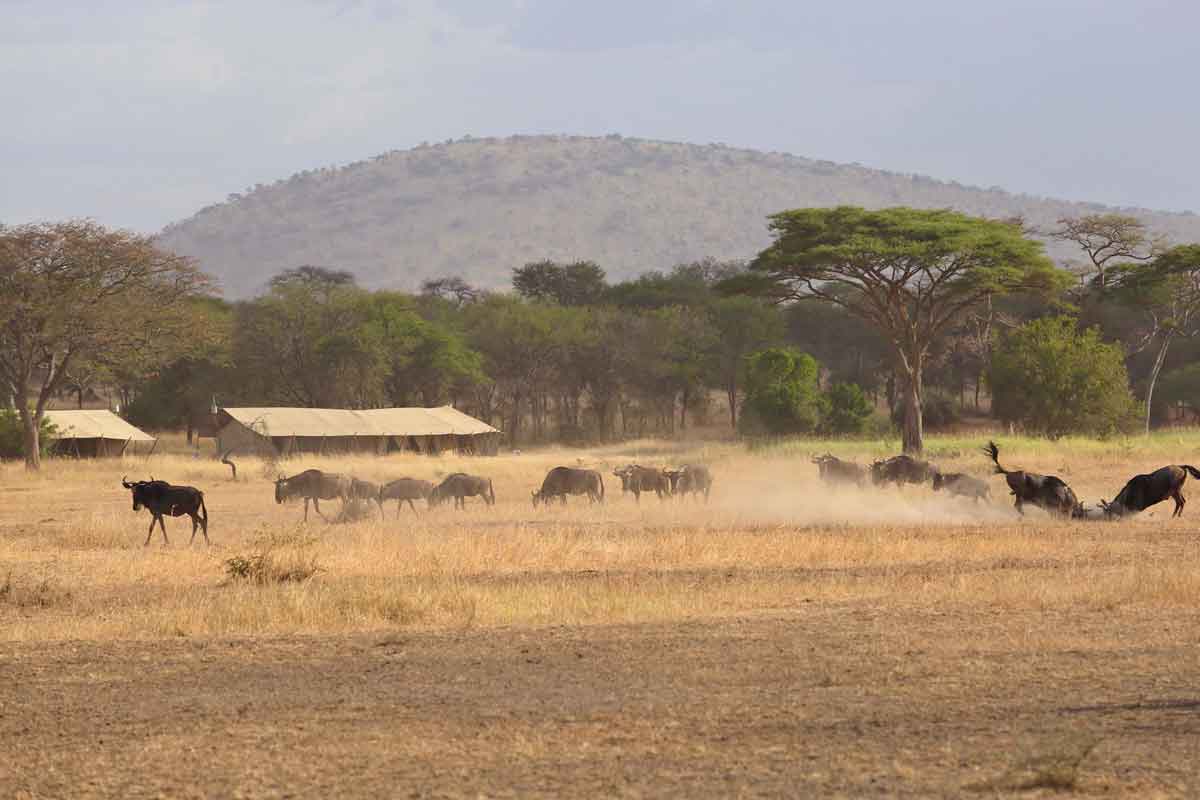


How to decide when to visit?
Do you want the high drama of a possible river crossing? You will need to travel from July to October into the Northern Serengeti or the Masai Mara. This time of year does command the highest rates, especially in Masai Mara.
Want to see the babies? February in the Southern Serengeti is the place to be.
Epic predator action on your wishlist? The lions, leopards, cheetah and hyenas are active all year through.
Keep in mind that if you choose a safari camp in the middle of the action, you will pay a premium. If you are budget conscious then have a look at the Central Serengeti as there is a wide range of accommodation and access to the migration for much of the year.
Natures Dramatic Lifecycle
Wildebeest Migration Map
Below is a map courtesy of Africa Geographic, which shows the general pattern of the wildebeest migration through the year.
